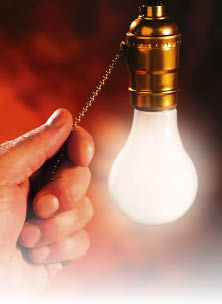The Light Bulb must not go out!
Politicians and environmental organizations portray the incandescent light bulb as an electricity-guzzling environmental bad guy. As a result, it is gradually being phased out over the next few years. Yet its replacement, the energy saving light bulb, is not so “green” as plugged. Its light does not only damage our eyes, but can even cause hormone-related illnesses – including cancer!

All glowed out: After 130 years our flash of inspiration is to be retired.
It seems as though the consumer harbours an almost instinctive antipathy to energy saving bulbs: despite massive promotion, only a seventh of all illuminants used in the EU were energy saving light bulbs. In Switzerland this quota was barely a fifth, if you include all neon bulbs. Little wonder, since energy saving light is cold – not nearly as cosy and warm as normal bulbs.
There is a demonstrable measurable reason for this: like candle-light, the incandescent light bulb emits a ‘natural light’ spectrum, which is similar to the sun in several aspects. All parts of visible light are present in balanced amounts, which is why one talks of a full spectrum light. This is completely different to fluorescent light, to which category all energy saving bulbs belong. This light spectrum consists predominantly of isolated peaks, explaining the disharmonic and penetrative nature of such light in our perception. Instead of a harmonic whole, only single, super-elevated energy peak light frequencies are measured. The same applies to so-called full spectrum lamps, warm tone lamps, daylight lamps or bio-light fluorescent lamps. Although these match the same colour temperature as daylight, the composition of their light radiation has absolutely nothing in common with sunlight.
But what’s the point of such nitpicking? Surely light is just light. The main thing is that it brightens up our surroundings sufficiently, right? Wrong - and a dangerous notion at that! Light is not simply present to chase away darkness, not by a long shot. Light is a foodstuff, and indeed the most important one we have. This realization has lead to the emergence of chronobiology and light medicine, a relatively new science based on the laws of quantum physics (see text box), no less. Light governs our hormonal balance, as well as cellular activity in the body. The wrong light at the wrong time interferes with the natural balances of life.
A difficult risk to assess
It is very difficult to estimate how much damage is actually wrought by artificial light, as living organisms are able to recover on a rolling basis. In order to be able to estimate the extent of such damage, it is essential to know how quickly and how robustly a body can regenerate. Yet this is hardly possible in practice, not least because, “for many years physicians have no longer been trained in the art of healing, but are urged to work and think highly scientifically i.e. physically,” according to light biologist Alexander Wunsch. Thus the biological equation “Injury = damage - repair” is increasingly fading into the background. The founder of psychosomatic medicine Thure von Uexküll once tellingly remarked: “Physicists have begun to believe in the Good Lord again – only physicians still believe in physicists.”
Consequently, one can observe the toxic effects of light primarily in experiments at a cellular level, or from epidemiological developments. “Since modern civilisations are subject to predominantly artificial light – in city dwellers, it is more than 95 percent of our waking hours – the first question must be whether we can really count the sun as the only decisive factor in light-related damage,” warns the physician Wunsch. “Yet precisely this occurs with regard to skin cancer, to the development of cataracts and to the emergence of age-related macular degeneration, by which almost a third of people aged over 65 in industrial nations have been affected.”
The role of artificial light, on the other hand, was barely investigated until very recently, although it is in fact the dominant light influence on us. That our psyche responds accordingly to it is a fairly obvious fact. In order to research this idea better, classrooms at a Hamburg primary school were fitted with a lighting system, whose intensity of illumination and colour temperature could be changed by the teachers. Bright, cold white light was supposed to energise the students in the morning, while a dim reddish light was meant to calm them down. It worked. For a year, the Hamburg University researchers compared the achievements of a class working under such dynamic light with a class working under standard illumination. Result: under the former, reading speed rose by approximately 35 percent. Attention and concentration improved, while disruptive hyperactivity was also positively influenced by the right light.
Cancer: when night turns to day
Rather less positive is the fact that artificial light can scramble our hormones. This means that illnesses that can be traced back to disturbances in the hormonal balance – such as cardiovascular problems, diabetes or even cancer – are ever increasing. New study results indicate a link between artificial light and the emergence of breast cancer. A link is also thought to exist between this type of light and both colon and prostate cancers.
Since 1987 American cancer researcher Richard Stevens has been warning that nocturnal artificial light can cause cancer in humans, mainly because light causes our internal clocks to get out of time, and the body produces too little melatonin – which also directly affects hormones. According to Professor Stevens, “Melatonin and breast cancer go together: for one thing, melatonin slows the growth of tumours. For another, it inhibits the production of estrogens. If less melatonin is produced, the level of estrogen rises. And estrogens play a significant role in the emergence of breast cancer.”
The Harvard Medical School stores data from 120,000 nurses, who fill out a questionnaire on their health every year. In effect, the more often nurses work nights, the more frequently they fall ill with breast cancer. Blood tests revealed that night nurses have considerably less melatonin and more breast cancer-encouraging estrogens in the blood. Similarly, another investigation on blind women concluded that these women fell ill less frequently of breast cancer than sighted women.
At the Institute for Occupational Medicine, Social Medicine and Social Hygiene, the Cologne University Clinic has evaluated around thirty studies from around the world on the topic of shift work and cancer, in which particular attention was paid to external clocks, in particular light. A crucial result of these meta-analyses demonstrates that there is a statistically significant increase in the risk of cancer in two occupational groups investigated, namely flight personnel and shift workers – particularly affected are flight personnel. The increase in the risk of cancer is 70 percent for breast cancer and 40 percent for prostate cancer. Professor Stevens also worked on a study which was published in February 2009: employees at the University of Haifa collected data on prostate cancer illnesses from a total of 164 nations, focusing on a possible link between the disease, artificial light at night and the electricity consumption in these countries. Their suspicion was confirmed: countries with an above average amount of nocturnal artificial light showed an approximately 30 percent increase in prostate cancer rates. The countries with the most intense nocturnal artificial light conditions showed 80 percent more prostate cancer illnesses!






